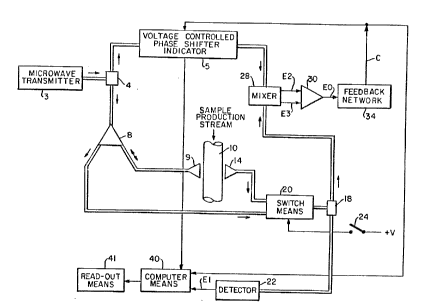Note: Descriptions are shown in the official language in which they were submitted.
20A51p~
CO-VARIANCE MICROWAVE WATER CUT MONITORING MEANS AND METHOD
BACKGROUND OF THE INVENTION
Field of the Invention
The present invention relates to microwave means and
methods of monitoring the water cut of a petroleum stream.
SUMMARY OF THE INVENTION
A co-variance microwave water cut monitor includes a
test cell having a petroleum stream flowing through it while
permitting the microwave energy to enter the test cell. A
microwave source provides microwave energy to a circulator
which in turn provides the microwave energy to an antenna.
The antenna provides the petroleum stream in the test cell
with the microwave energy and receives reflected microwave
energy back from the stream. The reflected microwave energy
is provided by the antenna to the circulator which in turn
provides the reflected microwave energy as test microwave
energy. A detector assembly connected to the circulator
detects the intensity of the test microwave energy and
provides a corresponding intensity signal. Indicator
apparatus connected to the microwave source and to the
detector assembly provides an indication of the water cut of
the petroleum stream in accordance with the intensity signal
and the phase difference between the source provided microwave
energy and the test microwave energy.
The objects and advantages of the invention will
appear more fully hereinafter, from a consideration of the
detailed description which follows, taken together with the
- 1 -
68626-497
~0~5~03
accompanying drawings wherein two embodiments are illustrated
by way of example. It is to be expressly understood, however,
that the drawings are for illustrative purposes only and are
not to be construed as defining the limits of the invention.
DESCRIPTION OF THE DRAWINGS
The drawing is a partial simplified block diagram of
a microwave water cut monitor constructed in accordance with
the present invention.
DESCRIPTION OF THE INVENTION
The water cut monitor shown in Figure 1 includes a
microwave source 3 providing electromagnetic energy,
hereinafter referred to as microwave energy, at a microwave
frequency. Source 3 is low powered and may use a microwave
gun source. Source 3 provides microwave energy to directional
coupler 4. Directional coupler 4 provides microwave energy to
a conventional type voltage controlled phase shifter 5 and to
a circulator 8. All conductance or carrying of microwave
energy is accomplished by using conventional type wave guides
and coaxial cable.
- 2 -
68626-497
.. 2005103 ~ 0 ~ ~ '~ Q
Circulator 8 provides microwave energy to an antenna
9. Antenna 9 transmits or radiates the microwave energy
through a sample stream of a fluid mixture passing through a
test cell 10. Test cell 10 may be a portion of a pipeline with
"windows" made of material which permits passage of the
microwave energy or it may be a portion of the pipeline made of
the "window" material. The transmitted microwave energy passes
through the fluid mixture and is received by an antenna 14
which provides the received microwave energy to a switch means
20 which in turn provides test microwave energy to a
directional coupler 18, as hereinafter explained. Directional
coupler 18 provides the test microwave energy to a detector 22
and to a mixer 28. Detector 22 provides a signal E1
corresponding to the intensity of the microwave energy received
by antenna 14.
The fluid mixture also reflects some of the microwave
energy back to antenna 9 which passes back through antenna 9 to
circulator 8. Circulator 8 blocks the reflected microwave
energy from feeding back to source 3 and provides the reflected
microwave energy to switch means 20. Reflected microwave
energy becomes more important as the distance between antennas
9 and 14 increases. This is especially true where a large
pipeline carrying the fluid mixture is being monitored.
A positive direct current voltage +V is provided to a
switch means 24 which is connected to switch means 20. With
switch means 24 open, switch means 20 provides microwave energy
from antenna 14 as test microwave energy. When switch 24 is
closed, the reflected microwave energy from circulator 8 is
provided by switch means 20 as the test microwave energy.
The microwave energy from voltage control phase
shifter 5, hereinafter called the reference microwave energy,
and the test microwave energy from directional coupler 22, are
provided to a mixer 28 which mixes them to provide two
-3-
2005103
~aa~~a~
electrical signals E2, E3, representative of the phases of the
reference microwave energy and the test microwave energy,
respectively.
A differential amplifier 30 provides an output signal
EO in accordance with the difference between signals E2 and E3.
Signal EO is a function of the phase difference between the
reference microwave energy and the test microwave energy and is
provided to a feedback network 34. Feedback network 34 pro-
vides a signal C to voltage control phase shifter 5, control-
ling the phase of the reference microwave energy, and to a
mini-computer means 40. Signal E0, and hence the signal C,
decreases in amplitude until there is substantially 90° phase
difference between the reference microwave energy and the test
microwave energy. Voltage control phase shifter 5 indicates
the amount of phase shift required to eliminate the phase
difference.
Signals E1 and C are provided to mini-computer means
40 which contains within it memory means having data related to
phase and amplitude for various percentages of water cuts that
could be encountered in the production stream. Phase Shifter
5 also provides an enabling signal to computer means 40 allow-
ing computer means 40 to utilize signals C and E1 to select the
proper water cut value computer means 40 provides signals,
corresponding to the selected water cut value, to readout means
44 which may be either digital display means or record means or
a combination of the two.
35
_4_
